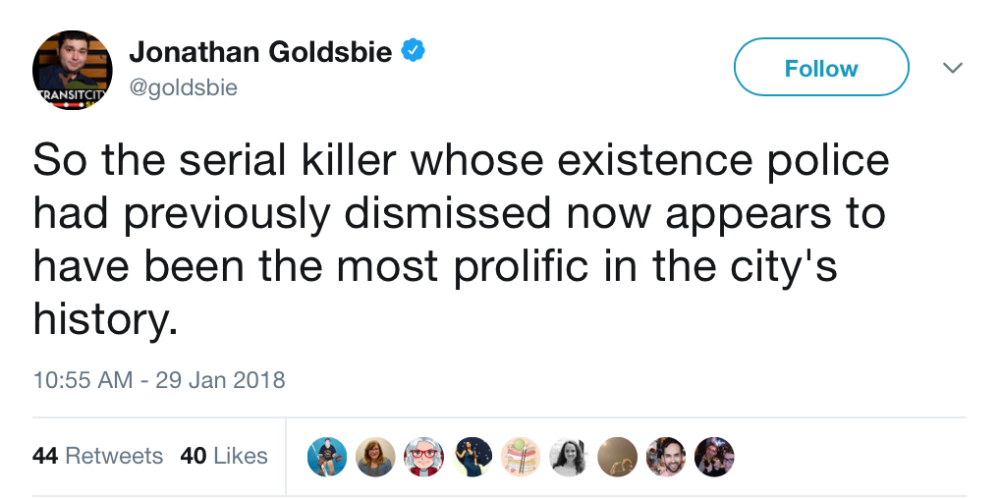Since the last time I posted about the Bruce McArthur case, additional info has been revealed that is… well, grim, to say the least.
Alongside the established first degree murder charges relating to the deaths of Andrew Kinsman and Selim Esen, McArthur is now charged with the murders of three more men – Majeed Kayhan, Dean Lisowick, and Soroush Mahmudi. Kayhan was one of three missing men in the Project Houston investigation of 2010-12, and confirmation of his murder at the hands of McArthur creates the first definitive link between that investigation and the Project Prism investigation of 2017 (which had been investigating the disappearances of Kinsman and Esen).
Mahmudi had been reported missing in Scarborough in 2015, while Lisowick had never been reported missing and was a regular of the shelter system in the city.
At a press conference yesterday, Sgt. Hank Idsinga revealed that skeletal remains of at least three unidentified individuals had been found in planters on the property of one of McArthur’s landscaping clients, and that they suspect more victims will be identified as they comb through thirty properties around the GTA. For the first time, they applied the term “serial killer” to the case, revealed that McArthur had gone to great pains to cover his tracks, and that the investigation was “unprecedented” given the sheer number of crimes scenes and victims apparently beyond Toronto’s gay community.
And the media has been leaving no stone unturned.
- The Toronto Star revealed that McArthur had been found guilty of a brutal assault against a sex worker back to 2001, and that part of his sentence was to stay away from the Church-Wellesley gay village.
- The Star also reported that police had seized one of McArthur’s vehicles from an auto shop back in September of 2017, and that it contained genetic evidence.
- The Star also interviewed the elderly couple who own the property where McArthur had been storing his gardening equipment and the planters that contained human remains. The article contains the following quote, which is chilling:

- The Globe and Mail found links between McArthur and four of the five missing men of Project Houston and Project Prism. They also interviewed men who had been sexually involved with McArthur, with more details about the seized van and his overall presence in the community.
- Daily Xtra revealed that Skanda Navaratnam (another man missing in the Project Houston investigation) had been in a long-term relationship with McArthur, and that he had been scared of his “violent temper.”
- The Toronto Sun reported that police saved a young man from McArthur’s apartment on the day of his arrest.
- Global News revealed that authorities found photos of the victims were on McArthur’s computer.
The reaction to the onslaught of news has been swift and intense, with everything from questions about police methods and their inability to protect marginalized communities to an analysis of McArthur as an organized serial killer and pieces about the victims.
The gay community in Toronto is more or less in shock, with a fair share of anger on social media. Whispers of a possible killer stalking the village have been around since 2013, but no one expected anything of this magnitude. And as more information is released to the public, it is becoming increasingly clear how organized and prolific a killer McArthur was, with the sheer number of victims he managed to kill including and possibly exceeding both Project Houston and Project Prism combined.

Moreover, he operated in plain sight, targeting marginalized men on the periphery of society, and then disposed of those victims in an impossibly ghoulish way that makes the entire city a possible crime scene. How could the police have missed this? And if the police had only been willing to see the connections in those early crimes, could any of these men have been saved? Did McArthur have to operate for close to a decade before he was stopped?
It’s all very troubling. As former police detective and university professor Michael Arntfield notes in this CBC piece:
“The way the victims were disposed in Toronto — their transportation and concealment either through obliteration, dismemberment or burial of a body — “speaks to an offender who has been honing this for some time.”
Typically, serial killers will also use their occupation as a way to acquire victims, and will use their time at work to scout locations, Arntfield said. “One of the things I look at is the nexus between occupation and opportunity in serial murder,” he said.
“These are allegations, but if proven to be true, it would appear McArthur used access to these locations and the equipment to help dispose of these victims.”
But Arntfield said McArthur at 66 doesn’t fit the known age demographic for serial killers. Serial murder, he said, has widely been thought to be limited to males 18 to 26 and that by 35, offenders are “aging out.”
If McArthur is guilty, he either started relatively late for a serial killer, or his crimes go back several decades, he said.”
The tip of the iceberg. He could have been preying on a community members for decades.
McArthur’s alleged murder spree is a first for Toronto, and impossible to believe in an era of constant surveillance. How could anyone disappear when so many people are watching? And how could anyone get away with killing so many men without attracting some kind of attention?
Perhaps what this case suggests is that – even with ever-present video cameras, smartphones, and GPS trackers – only certain members of society are being actively watched. That only certain members of society attract suspicion of criminality, while others fail to attract attention when they disappear. It’s important to note that it took a missing white male of a certain socio-economic strata to really get police to pay attention and make the first real strides in this case.
The other men just fell though the cracks.